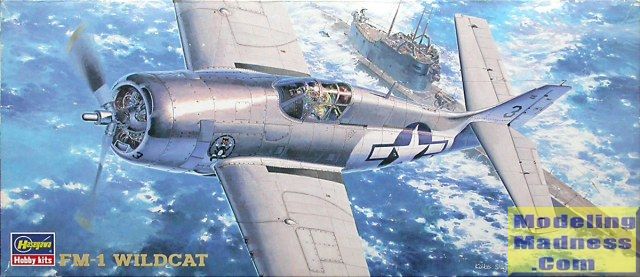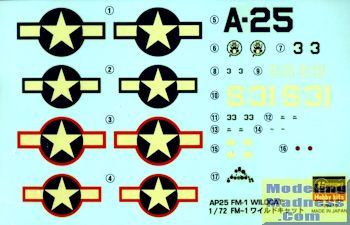
| KIT #: | 51325 (AP25) |
| PRICE: | $5.00 from a vendor |
| DECALS: | Two options |
| REVIEWER: | Scott Van Aken |
| NOTES: |
New tool kit |

| HISTORY |
The stubby little Grumman Wildcat is the epitome of the US Navy's fighter force in the first year of the Pacific War. An aircraft that was built to withstand the rigors of carrier operations, yet have enough firepower to handle enemy aircraft, the Wildcat was the initial loser in a competition to build the Navy's first monoplane, retractable landing gear fighter aircraft. The winner was the less than sterling Brewster F2A Buffalo. Despite not being capable an aircraft as was the Buffalo, it did provide the needed operational experience with the type. Though it was a disaster against the Japanese with both US and Commonwealth forces, the Finns used the type with much success against the Soviets in 1940 and later.
The initial production F4F-3 Wildcat had fixed wings and four machine guns. This was later replaced by the folding wing F4F-4 with six machine guns. The folding wings allowed more aircraft to be carried on ships, but added weight that affected the performance. Most pilots did not like the additional two guns as it not only meant more weight, but fewer rounds per gun and so a shorter firing time.
Regardless, the Wildcat was built in considerable numbers, a lot of them by General Motors who took over production once Grumman got well underway with the Hellcat. The Wildcat was a perfect aircraft for the smaller carriers as it was rugged and able to provide the needed convoy protection against German long range bombers in the Atlantic. The type rapidly disappeared once the war was concluded.
| THE KIT |
 All
of the various boxings of Hasegawa's Wildcat are pretty much the same. The only
differences you will find is that the very early Wildcats had a pitot tube that
jutted out the leading edge of the wing and a pointed prop hub. Depending on the
boxing you get, you'll have a replacement pitot for under the wing and/or a
flatter prop hub. The boxings of the non-folding wing F4F-3 will include
instructions on filling in the unnecessary folding wing lines and the
extra gun ports.
All
of the various boxings of Hasegawa's Wildcat are pretty much the same. The only
differences you will find is that the very early Wildcats had a pitot tube that
jutted out the leading edge of the wing and a pointed prop hub. Depending on the
boxing you get, you'll have a replacement pitot for under the wing and/or a
flatter prop hub. The boxings of the non-folding wing F4F-3 will include
instructions on filling in the unnecessary folding wing lines and the
extra gun ports.The kit provides a nice, if rather basic cockpit that includes a seat, stick and an instrument panel on which one puts a decal. This is probably the weakest area of the kit. The floor is solid, which is non-prototypical as the Wildcat had windows in the lower belly through which the pilot could look.
The wheel well is also somewhat devoid of detail. On a real Wildcat, one could see the engine accessory compartment and the chain drive for the landing gear operating system. None of that is present in the kit, though aftermarket will take care of this and the cockpit situation. The canopy is a single piece so must be cut to display any cockpit detailing you do.
The rest of the kit is well done and despite the number of kits produced from these molds, this kit is still crisply done without a lot of problems with ejector pin marks or sink areas.
 Hasegawa's
instructions are pretty standard for their smaller kits. A fold out sheet has
the six construction steps and a parts layout as well as the Gunze paint chart
on one side while the other has a history, various warnings, and the painting
and markings guide on the other. The first of two options is the box art plane
with VC-12 in the "Atlantic" scheme of dark gull grey over white. The other is
from VC-33 in the tricolor scheme with large codes on the wings and fuselage.
Decals are nicely printed, but typical of what was offered over 20 years ago.
The decals are thick with whites that are decidedly off white. I'd at least
replace the insignia with aftermarket.
Hasegawa's
instructions are pretty standard for their smaller kits. A fold out sheet has
the six construction steps and a parts layout as well as the Gunze paint chart
on one side while the other has a history, various warnings, and the painting
and markings guide on the other. The first of two options is the box art plane
with VC-12 in the "Atlantic" scheme of dark gull grey over white. The other is
from VC-33 in the tricolor scheme with large codes on the wings and fuselage.
Decals are nicely printed, but typical of what was offered over 20 years ago.
The decals are thick with whites that are decidedly off white. I'd at least
replace the insignia with aftermarket.
| CONCLUSIONS |
September 2015
If you would like your product reviewed fairly and fairly quickly, please contact the editor or see other details in the Note to Contributors.